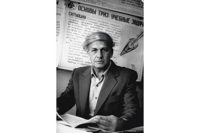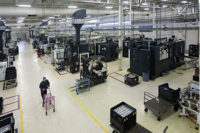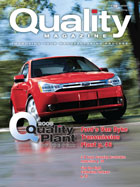
The people at the Van Dyke Transmission Plant (Sterling Heights, MI), just outside Detroit, know what is going on.
It is no secret that the economy is not what it used to be in Michigan. The economy is struggling, housing prices have dropped and many jobs have left the area.
However, at the Sterling Heights, MI, plant, things are booming. At the time of my visit, the team had finished transforming the factory floor for the introduction of the 6F (front-wheel drive) mid-range transmission area, slated to begin production in late March. The look and feel of the area is bright and inviting with fresh paint colors and better lighting. Gone are the dingy army-green colors from this area, replaced by soft gray and lighter colors-the better to notice dirt and contamination, and thus easier to clean. This section looks like the after image of a before and after transformation.
While the surface looks different, the processes and technology are different as well. The plant will soon be producing all of the 6F mid-range transmissions for Ford. This gains the plant some notoriety, and the employees are proud of that.

Van Dyke transmissions are used in the Ford Focus. Source: Ford Motor Co.
People
While this technology is state-of-the-art, people made it happen. Plant Manager Alexandria Maciag, who has been here six years in June, is proud of the employees’ work at Van Dyke, and rightly so. As countless employees pointed out, the plant would not be here today without its people. Each new technology-from digital holography to minimum quantity lubrication-was someone’s idea. Without the employees, new technologies would not have been implemented and embraced.“We take a lot of pride in what we do here,” Maciag says. High morale does not just make for a good working environment. It also makes for a working environment, period. The employees take pride in their work, and know that passing defects on to another department is bad business. Good parts mean good products and, ultimately, good jobs.
Working closely with the UAW also has been invaluable. The plant’s successes would not have been possible without them, Maciag says.
Another indication for quality leadership is Ford Motor Co.’s structured process for development and prove-out of new technologies, which begins with concept proposal and ends with implementation readiness. Aiming to build superior 6-speed automatic transmissions, management and production personnel both were involved throughout these development phases so that they could provide their input and be ready to use these new processes.
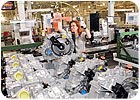
Kim Flansburgh, 6F transmission final assembly technician, packs off a completed and
fully tested transmission for shipment to the vehicle assembly plant. Source: Ford Motor Co.
Safety
The transmissions go across the state, country and the globe, from other plants in Michigan to around the world, including China-“We can’t give China enough,” says Maciag-Argentina and Russia.With such a worldwide reach, quality and safety are both taken seriously. As one UAW representative said, “They came in here with these,” wiggling his fingers, “and we want them to leave here with them.” No one wants to call an employee’s home and report that something has happened to their loved one.
Several mechanisms are in place to improve safety and prevent accidents. For one, separating people from the vehicles aids safety. Van Dyke has designated several fork-free zones, to reduce the number of forklift trucks in the area. The plant has walkways designed to keep people and machines from collisions, and to eliminate blind corners. In terms of days away/restricted time (DART), or safety issues, the plant has 0.3 cases per 200,000 hours worked.
Employees also wear earplugs and safety goggles, and if they wear glasses, they now wear protective side shields with them.
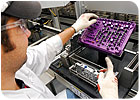
Ron Blandino, 6F transmission main control assembly technician, assembles a main control utilizing components from a pre-packaged kit. The use of pre-packaged kits in conjunction with lint-free clothing helps eliminate risks of contamination. Source: Ford Motor Co.
Quality
“As we resolve quality, it affects safety, morale and cost,” says Quality Manager Lisa Cittadino, who explains the plant’s quality operating system (QOS). QOS involves a quality team manager, then quality managers and quality engineers. A QOS coordinator sees to it that everything is running smoothly.The goal is to continually improve. Improvement programs include Six Sigma, which has yielded significant cost savings for the company. Black Belt and Green Belt training is ongoing, with the goal being to align projects with plant objectives and allocate resources accordingly. The majority of improvement issues relate to quality control.
This facility implemented advanced manufacturing technologies beneficial for not only quality but also safety, cost, morale and the environment. These factors are all elements of Ford’s measures for business success, namely SQDCME-safety, quality, delivery, cost, morale and environment.
Both the workforce and management have embraced these new technologies and set the standard for high-performance, high-volume, environmentally friendly and quality-focused production. The people are closely involved in the development and deployment of these innovative manufacturing technologies.
“The most important thing is the people,” Maciag says, and she means it. This isn’t just a saying-it is put into practice. The plant offers extensive training, from the employee orientation to yearly refreshers. And by improving the environment and lighting, the mindset is a lot better as well.
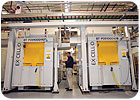
Wes Houston, 6F transmission machining controls engineer, enters program modifications on one of 80 CNCs in the 6F machining area. The programmable nature of the CNC allows for far more flexible machining as compared to the single path transfer machines of the past. Source: Ford Motor Co.
Plant Tour
The employee enthusiasm is visible on the plant floor. All of the employees are eager to explain their jobs, and obviously take their work seriously.This is evident with the main controls, “the brains of the transmission,” that are made in a clean room. Even the tiniest contamination can interfere with its function, so employees and visitors to the room wear lab coats.
Later, walking past the new line, Maciag is anxious for the work to begin. “I don’t like it when it’s quiet,” she says. “I like it when it’s loud.”
The new area has not been quiet for long. The changeover was done remarkably fast-14 months instead of 20 to get the plant ready for the new line. The advanced manufacturing technologies, as well as the skilled work force, allowed the Van Dyke Transmission Plant to successfully introduce two high-volume, all-new 6-Speed FWD transmissions to the market in a short period of time. Both programs launched approximately 18 months apart from each other, while at the same time going through extremely aggressive launch ramps.

The Van Dyke Transmission Plant in Sterling Heights, MI, opened in 1968. Source: Ford Motor Co.
Green Factory
Van Dyke Transmission Plant incorporates environmentally friendly technology, a “green factory approach,” for machining complex aluminum transmission cases, converter housings and valve bodies using high-performance computer numerical control (CNC) machining centers. The machining system uses high-speed, linear motor machines with minimum quantity lubrication (MQL) technology.Coolant can add significant costs to an operation, not to mention the potential for a slippery work environment. To combat this, the plant has embraced the MQL technology.
With MQL machining, the metal removal process is performed nearly dry, which means no high-volume flood cooling system in the production line. Consequently, the resulting consumption of metal working fluid (MWF) per part is now measured in milliliters per hour instead of gallons per minute as with conventional wet machining systems. Precision machining operations in this production system incorporate real-time thermal compensation technology to guarantee part quality. The machine, part and ambient temperature are measured before and during machining. Using these temperature measurements, the machine positions are controlled to achieve high precision. The plant also implemented tooling, gaging, calibration and process control technology into production to achieve high productivity, high quality, low scrap, low life-cycle cost and high customer satisfaction rates.
With the introduction of MQL to machining processes, the tool rotational balance for high speed, precision-cutting tools is no longer affected by the coolant mass within the tool. Production data revealed that the precision bore quality with respect to roundness and size is better with MQL technology than with wet machining by approximately 25 to 50%, using the same cutting tools.
All machining centers use a real-time, vibration-based machine and process health monitoring system that provides an indication of spindle and slide health, along with tool/process state. This monitoring technology ensures quality, improves uptime and reduces cost. It also provides an indication of deviation from a normal operating state, thereby eliminating or reducing scrap. To date, the system has successfully identified spindle degradation prior to catastrophic failures, and has successfully identified dozens of tooling failures, dramatically limiting scrap production.
With the elimination of flood coolant by implementing MQL, new methods for chip handling are required. Ford has solved this challenge by using dedicated chip evacuation systems from Handte.
Each CNC machining center uses its own Handte chip evacuation device that is integrated into the machine tool. This method creates an air circulation. Chips, dust, air and oil mist are carried out of the machine envelope and run through a centrifuge and then a filter system at the back of the machine. Dry chips fall into the chip hopper and “clean air” is being returned back into the machine envelope (return air).
In order to create a vacuum, only 70 to 90% of the air is being returned to the machining zone and the remaining portion gets released into the plant. An emission study has proven that the return air is even cleaner-by a factor of two-than the usual office air. As a side effect, this chip handling technology contributes to significantly better plant air, particularly when considering that there are more than 120 machine tools using MQL at the Van Dyke facility. The air quality improvement compared to traditional wet machining significantly exceeds a factor of 10.
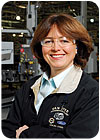
Alexandria Maciag
Plant of the Year
Using the MQL technology as one reference representing quality, innovation, technology leadership and competitiveness, the new program investments were drastically lowered (seven-figure savings due to elimination of coolant tanks and high pressure coolant supplies). As a result, the part piece costs, such as valve bodies, have been reduced by approximately 15%.In addition, Van Dyke is the first automotive plant to incorporate digital holography technology from Coherix into high-volume valve body production. This technology produces a high-definition measurement of the valve body surface-about 1 million points at 150-micron X-Y lateral spacing-to precisely measure and control zone and overall flatness. This technology is implemented directly on the plant floor to provide rapid process feedback.
Introducing these advanced technologies for two major transmission programs at the Van Dyke Transmission Plant, the product quality and the environmental quality benefited significantly.
Van Dyke employees, congratulations from all of us at Quality Magazine. Keep up the good work. Continuous improvement is not an easy assignment, but everyone, from management to hourly employees, has embraced that idea. The team has proven the benefits of hard work, and made Van Dyke a success story.Q


